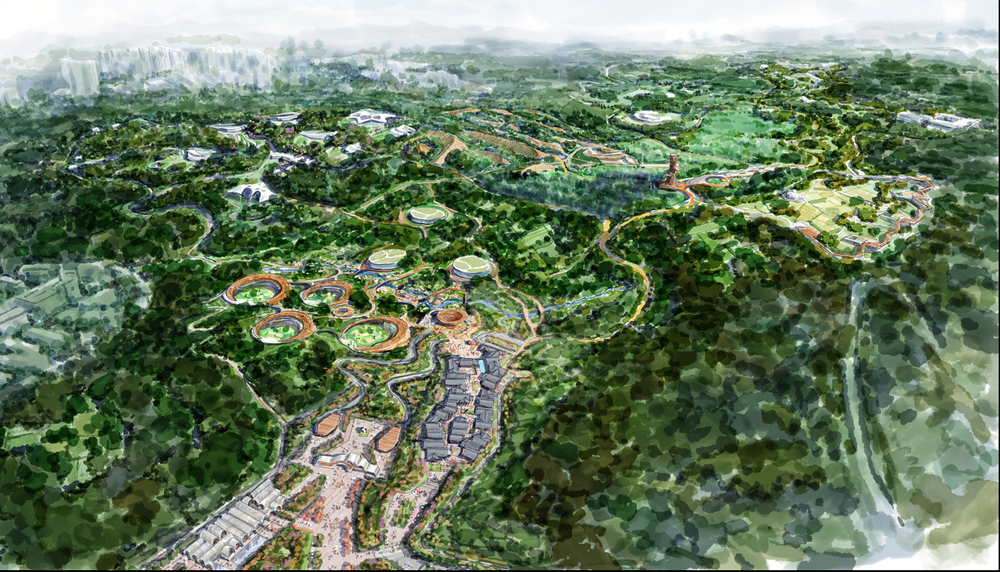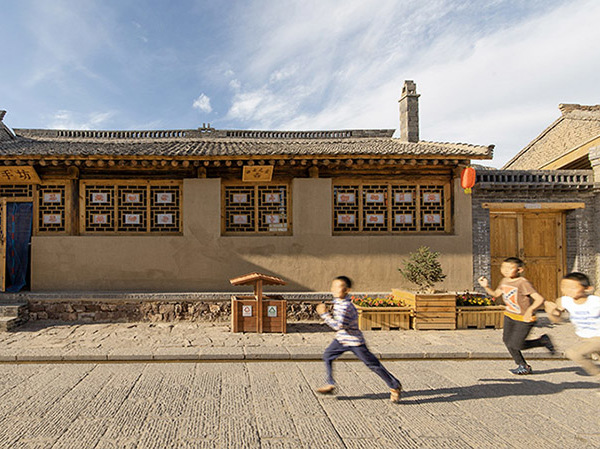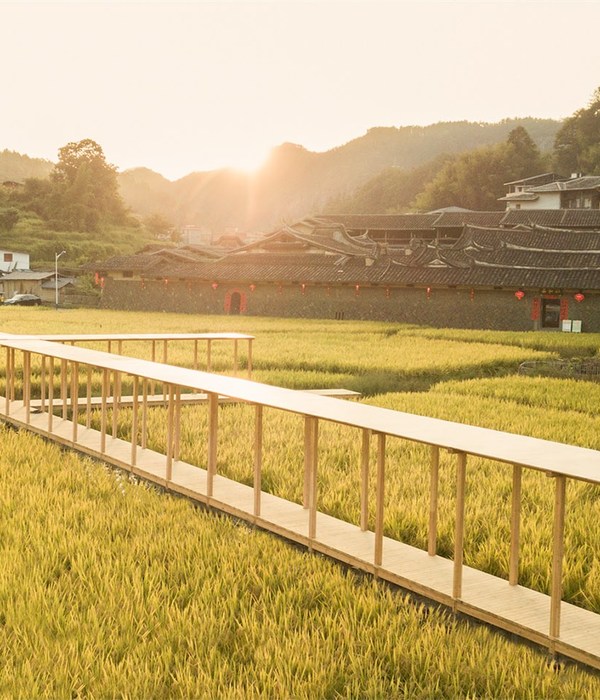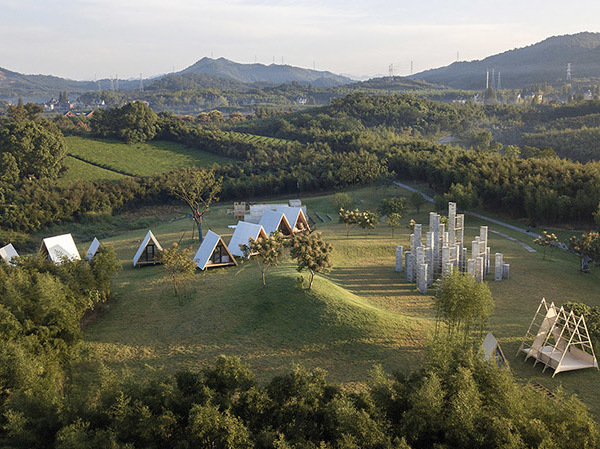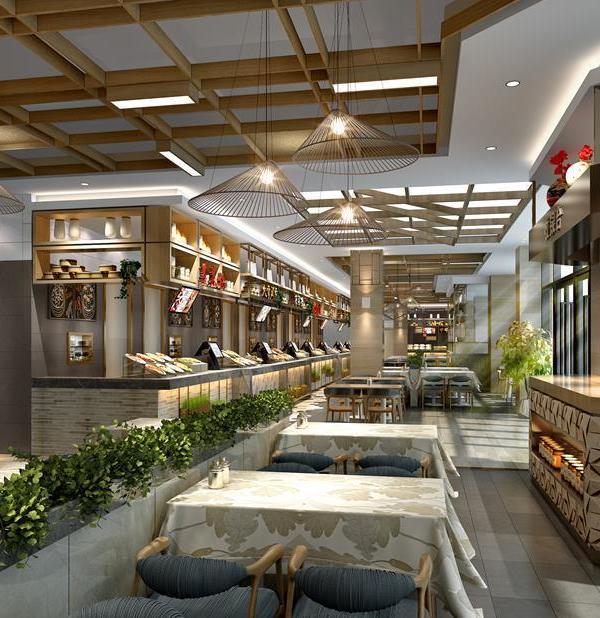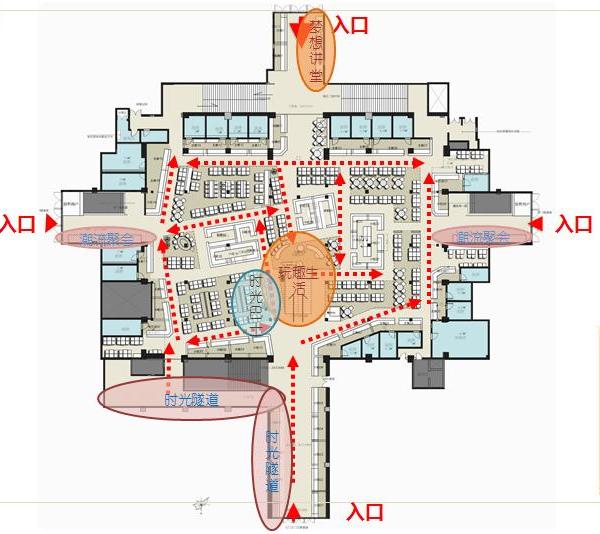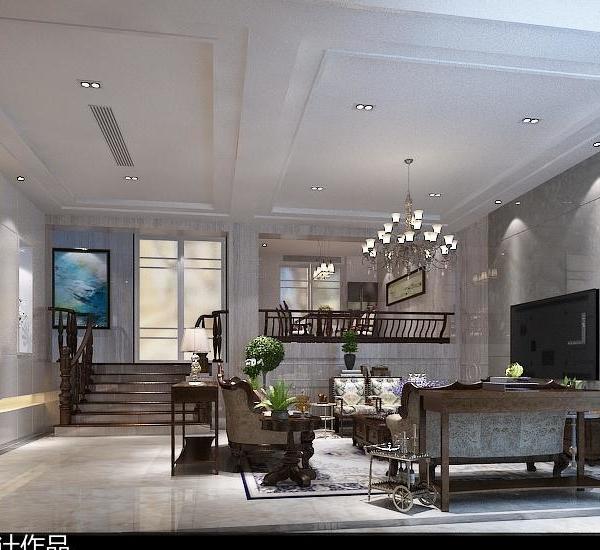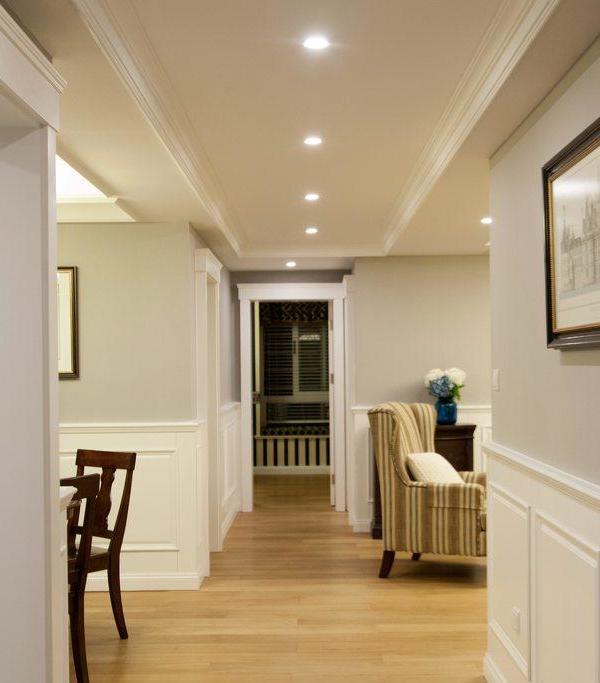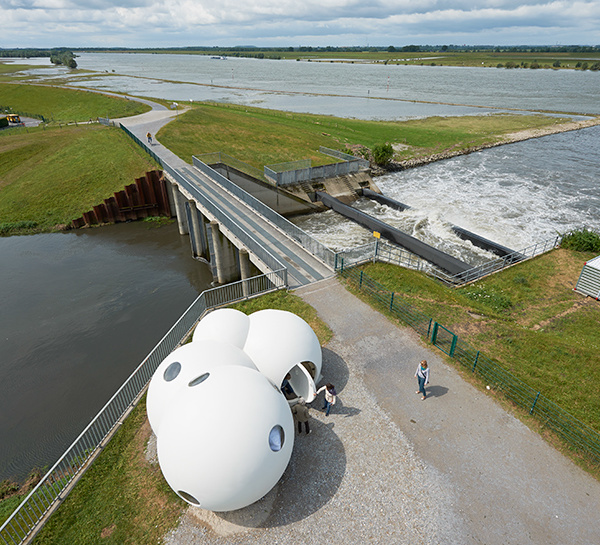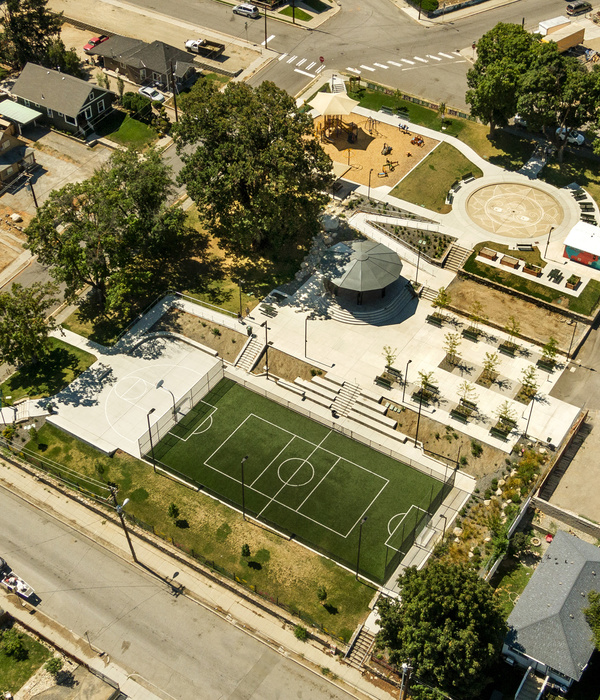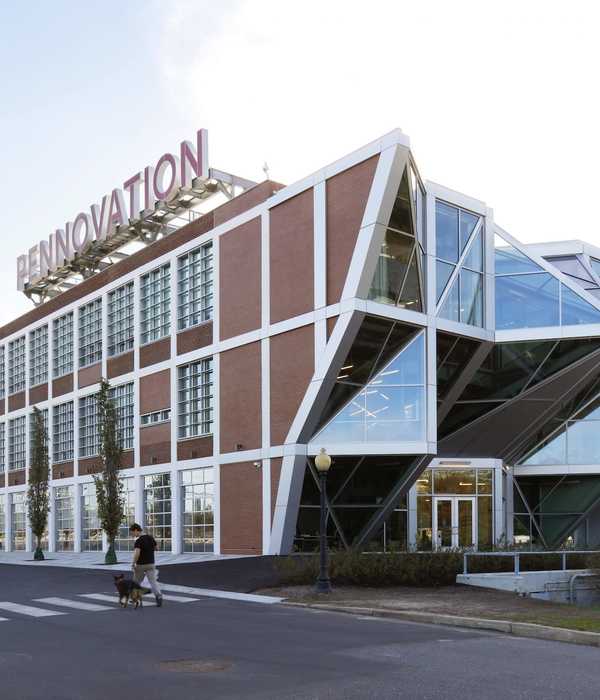成都大熊猫繁育研究基地 | 人类与动物和谐共生的现代典范
由于野生大熊猫种群数量仅剩1800只且仅生活在中国的西南区域,因而大熊猫是我们生存的这个星球上独一无二的珍稀物种之一,它即是中国的国宝,也是全人类共有的自然遗产。而中国四川成都大熊猫繁育研究基地,是最早拯救熊猫的基地之一。随着成都市在过去的40年中高速的城市化发展,它成为唯一一处在城市中的熊猫研究基地。同时也承担起科研以外,更多旅游及城市休憩的功能。如何在城市中,改造一座既能最大程度上还原熊猫及其伴生动物的原生生境,又能丰富游客自然科普需求的熊猫基地,是项目的出发点。
Giant panda is not only a national treasure of China, but also a beloved worldwide symbol of natural heritage. Right now, there are merely 1,800 left in the wild and all of them are native to the same southwestern region in China. In the past 40 years, Chengdu has gone through rapid urbanization, and the Panda Base is now the only research institution in the urban area with public transportation to downtown. Thanks to the great accessibility and the near-universal adoration of giant panda, the Panda Base has over 10 million annual visitors, surpassing that to the Shanghai Disneyland. Besides its wildlife protection and research mission, the Panda Base also plays an increasingly important role as a public recreation facility. We’ve constructed a strong strategy to reconcile Chengdu’s urbanization through restoring giant Panama’s natural habitat along with its companion animal, incorporating worldwide collaborative research, and promoting splendid educational outreach.
▼近景鸟瞰:游客与后勤线路互不干扰,Arial View of Panda Enclosure ©成都天府绿道建设投资集团有限公司
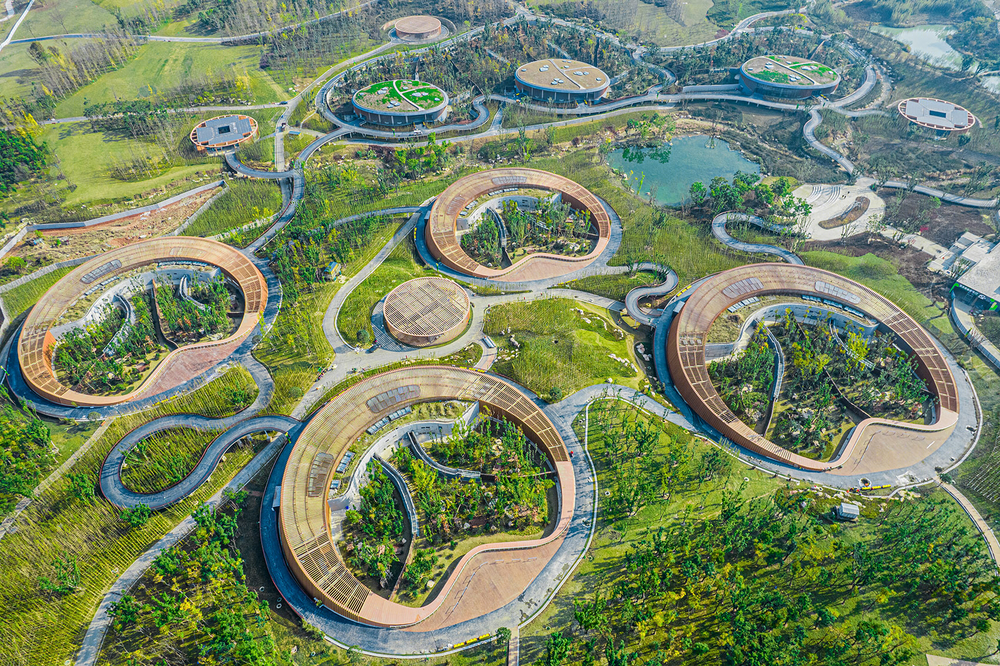
但是原有的大熊猫繁育研究基地从以下三个维度来看,亟待改造扩建。 1. 从动物保护视角,在原有大熊猫繁育研究基地0.69KM2范围容纳了约80只大熊猫,已造成大熊猫场馆室内外生活空间局促,无法模拟大熊猫自然栖息地的生境; 2. 从科研保育视角,有限的场地使得现代化的科研设施无法建成落地,并引起游览路线和后勤管理路线交织等一系列的问题; 3. 从游客体验视角,923万年游客量,瞬时高峰游客量可达10万人/天,极大降低了游客的游憩舒适度。因而如何在用地规模控制和建设强度管控的约束条件,改扩建大熊猫繁育研究基地是项目的重要挑战。
▼大熊猫繁育研究基地改扩建项目区位及范围,Location Map © 天华规划 Tianhua
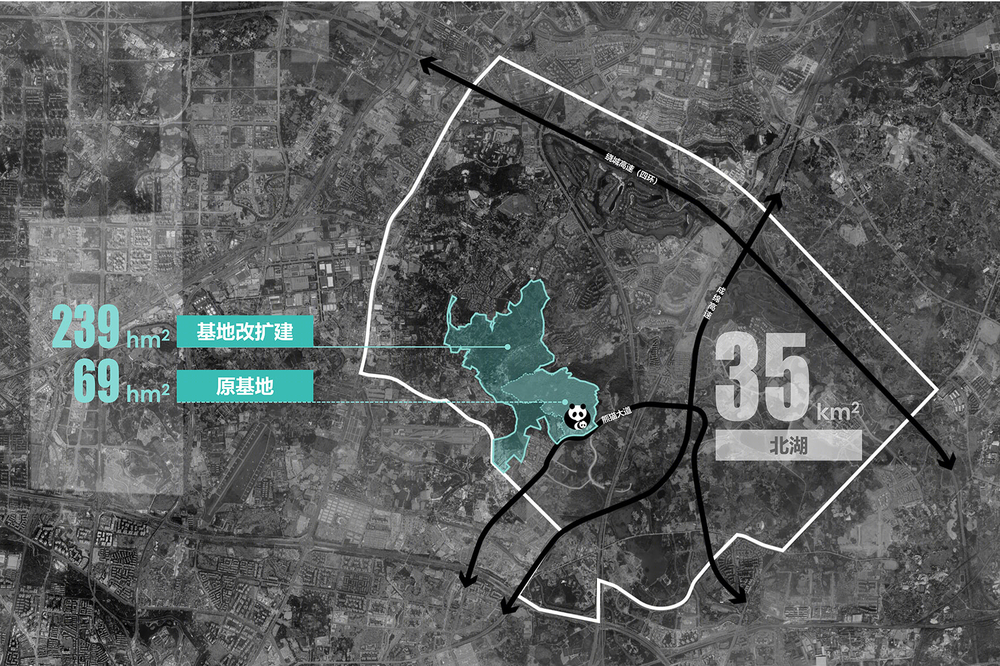
From our research, the existing Panda Base requires expansion to enhance its species protection framework in three main areas. 1. Animal Protection. 80 giant pandas are living within a 69-hectare site and the limited usable space jeopardizes their health and lifespan. Also, it usually requires at least 1000m2 outdoor area for every adult panda in order to successfully restore its wild natural habitat. 2. Scientific Research and Conservation. More space is required for advanced scientific research facilities and convenient logistic circulation. 3. Tourist Experience. In 2018, there are 9.23 million visitors with a peak volume of 100,000 visitor/day. Due to limited space, visitors can hardly enjoy their adventure. With that being said, the main goal of this expansion project is to optimize the limited land use towards a more sustainable wildlife conservation.
▼近景鸟瞰:冒险溪谷片区的大熊猫馆,Close Arial View of Panda Enclosure © 成都天府绿道建设投资集团有限公司
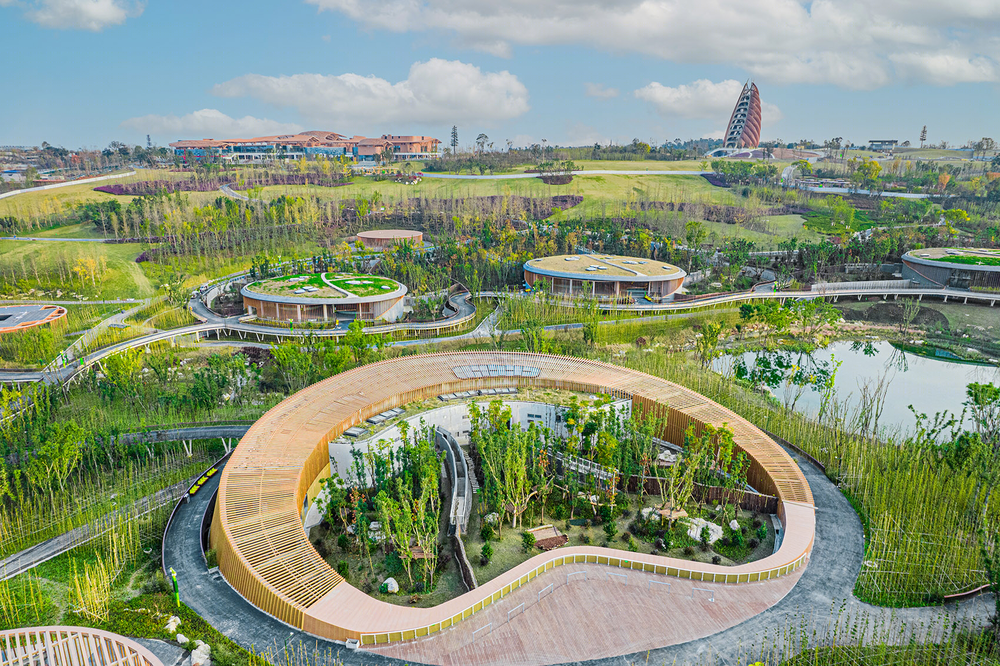
项目从友好理念整体出发,构建动物友好、人类友好的系统维度。在动物友好方面,从动物福祉角度考虑,充分考虑大熊猫在生理、环境、卫生、行为等方面的习性及偏好,致力于在有限空间范围内最大化实现大熊猫科学繁育、保护和有限的利用,最大程度上还原熊猫及其伴生动物的原生生境,不干扰动物自然行为,为以大熊猫为代表的动物营造一片融入人类城市的自然生活天地。在人类友好方面,满足游客对熊猫及自然更多的感知和认知需求,提供自然科普教育理念的培育与熏陶,在尽可能减少人类游览活动对动物影响的原则下进行园区功能划分及游线设置,打造沉浸于自然、邂逅动物的游览感受,让项目成为人类与动物美好时光的共享地。
▼响应场地特征的规划布局, Coupling with Nature ©天华规划Tianhua
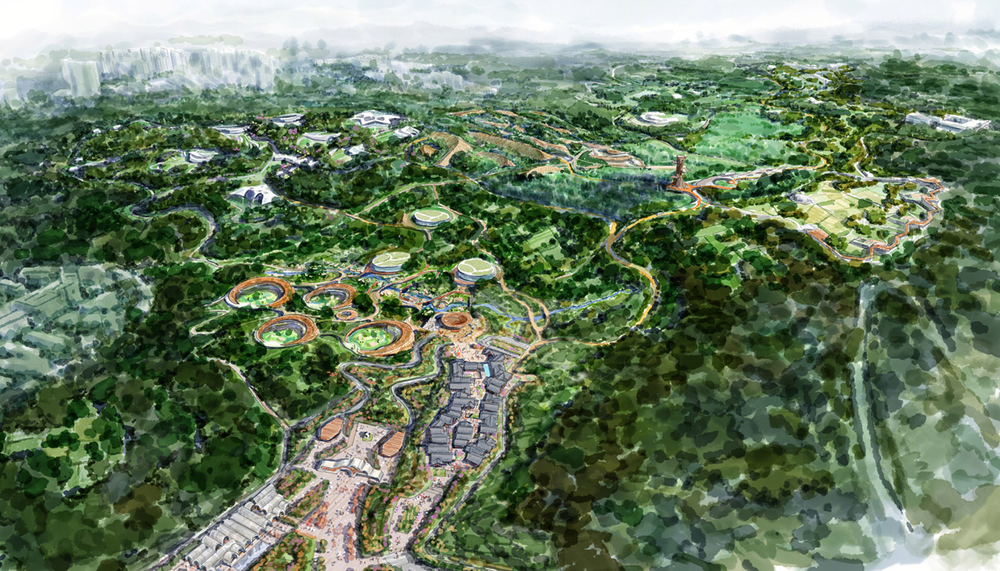
The project originates from the “friendly” vision and systematically develops the “animal friendly, human friendly” concept. In regard to “animal friendly”, it focuses on the animal welfare and fully restores its native habitat and the natural behavior. With thorough sturdy of giant panda’s physiology, behavior and its preference of living environment and hygiene conditions, we aim to scientifically optimize giant panda reproduction and species protection within very limited space and merge its natural living space and companion animals into the urban area. In regard to “human friendly”, it focuses on fulfilling people’s desire to know and feel more about the giant panda and its habit and providing science education opportunities to the public. The panda base functionality and the tour route are divided in a way to minimize its impact to animals’ lives and also to provide wonderful and immersive touring experience.
▼熊猫馆,Panda Enclosure © 成都天府绿道建设投资集团有限公司

动物心目中的好的动物园首先是一座充分模拟动物生境的家园,因而新的大熊猫繁育研究基地需成为以动物而非人作为主体的动物园。游客只是进入到动物的自然栖息地的过客,动物笼舍的设计应该从“动物的展位”改变成“应该会有动物出现的场所“,所以大熊猫得以沉浸在最适宜的原始栖息地环境中展现最自然的生活状态。 为了保证动物福利的最大化,我们采取了三种规划手段: 1. 结合动物友好的保护因素及场地条件,并叠加交通组织及展示教育功能的需求确定最优化的馆舍布局方式; 2. 在条件允许的范围内,最大化室内及室外的活动场地,并通过丰容设施尽可能还原大熊猫野生环境中的微气候、植物配置、地形地貌、坡度、湿度等特征,例如在冒险溪谷片区,我们依托流经场地的溪流布置大熊猫室外活动场所,并且尽可能利用朝南的缓坡地形打造植物郁闭度为50%左右的竹林生境; 3. 依据不同片区的展览主题及场地特征,设计以浸入式和隐蔽式为主的观赏方式,并尽可能规避游客活动所导致的大熊猫刻板行为的发生。
▼动物馆舍布局模式探索, Enclosure Layout Test ©天华规划 Tianhua
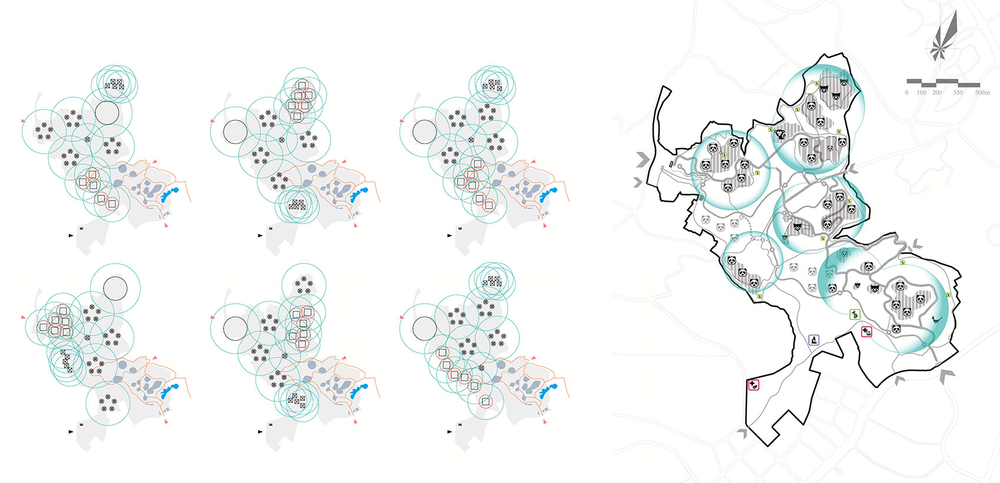
▼大熊猫馆景观丰容,Environmental Enrichment Method ©天华规划 Tianhua
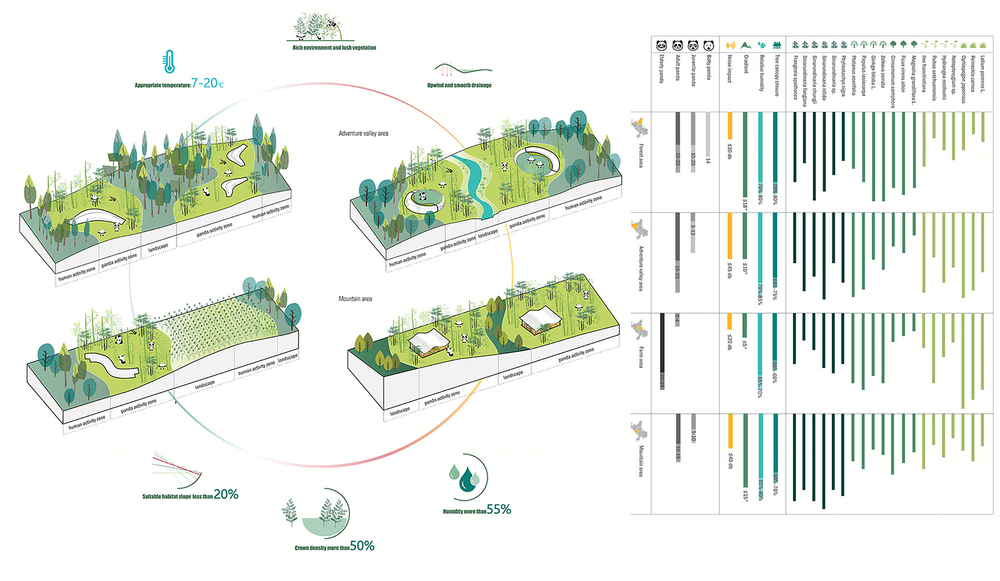
A good zoo to animal is a zoo that fully simulates the native habitat. Tourists are only visitors who enter into the animal’s habitat in an animal- focused zoo. The design of the animal enclosures should be ‘the place where animals could appear’, rather than ‘animal exhibition’. Animals should be immersed in the most appropriate habitat, showing the most natural statue of life. In order to maximize the animal welfare, three planning methods are taken. 1. An enclosure planning method that optimizes animal protection within space condition constraints, transportation and education needs 2. An environmental enrichment method that fully restores giant panda wild habitat condition such as micro weather, plant landscape, slope, moisture level, etc. and maximize the inside and outside space for the giant panda. 3. An immersive and hidden observing method that bases on different area and designed theme to eliminate giant panda stereotypic behavior influenced by tourists
▼近景鸟瞰:规划布局顺应周边环境,Arial View of Panda Enclosure © 成都天府绿道建设投资集团有限公司
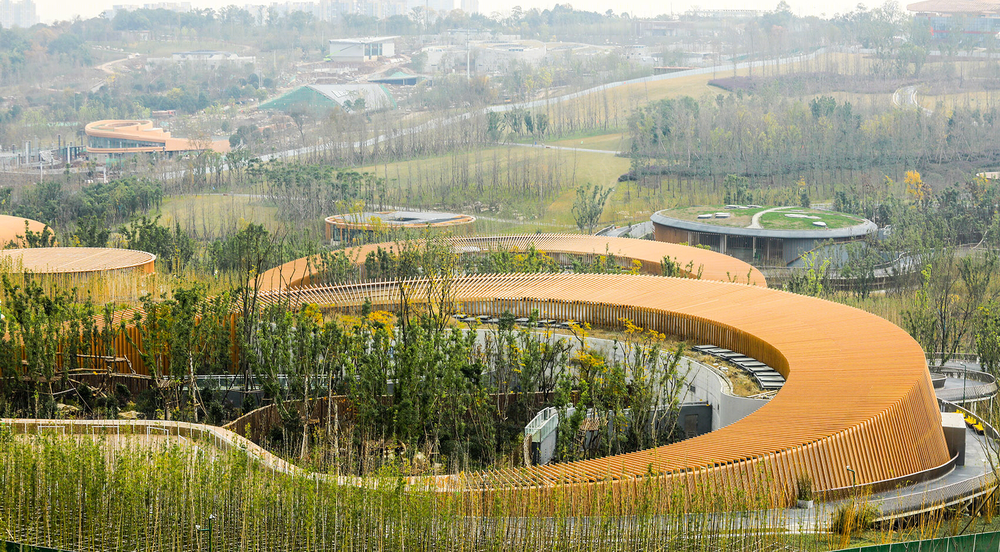
▼熊猫馆内部,Panda Enclosure ©成都天府绿道建设投资集团有限公司
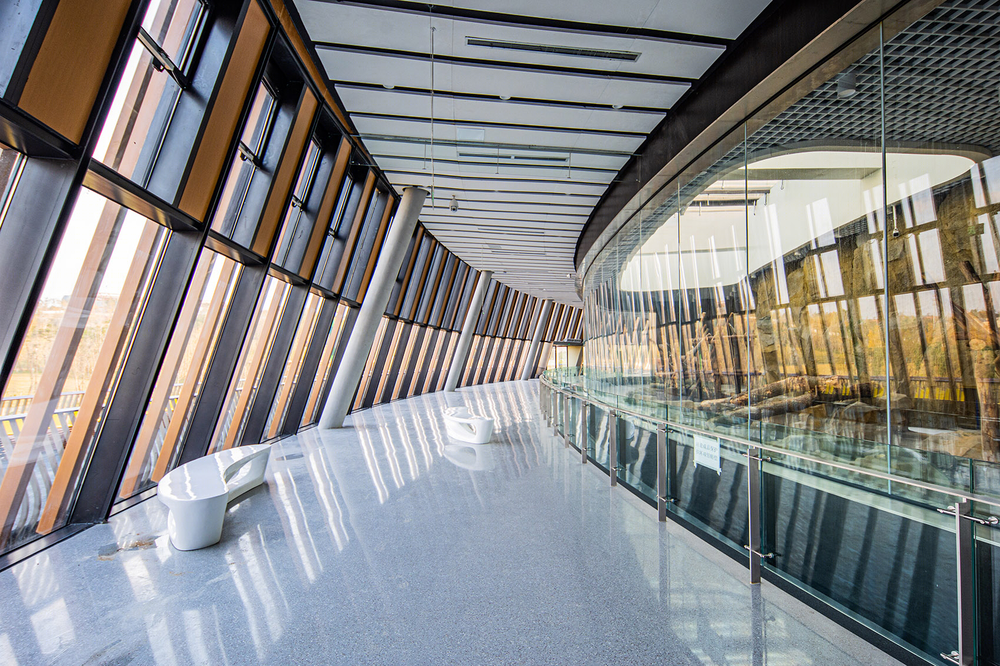
为实现动物福祉,让管理人员更加高效便利地完成包括动物的饲育、动物场馆的展示、以大熊猫为代表的珍稀动物的科学研究的主要职责,项目通过优化园区内的布局, 建设高标准的珍稀濒危野生动物诊疗与疫病防控中心等科研设施,同时提供便捷的园区环形后勤通道,并辅以数字化的信息管理系统,例如通过传感器等智慧设施的布局和应用等,监测熊猫健康状况、运动轨迹、环境信息,更好地保护大熊猫。由此创造了一个国际化和现代化的工作环境,让工作人员热爱并享受在这里自在工作的感觉,这样他们才能够更好的沉浸在不同的工作环境中,推动工作效率与质量的提升。
▼后勤流线&科研设施,Logistic Circulation & Scientific Infrastucture ©天华规划 Tianhua

In order to achieve animal welfare, and to enable people to more effectively feed, exhibit, research and protect endangered specifics like the giant panda, we optimize the layout of enclosures, construct cutting edge disease prevention and control center of endangered wild animals, and meanwhile provide convenient logistic circulation with digital information management system such as smart infrastructure using sensors to monitor pandas’ health, movement trajectory, environmental information, etc. With all the effort, we create an international and modern working environment that people enjoy working. Since they can better immerse in different working spaces, it greatly increases their working efficiency and quality.
▼人车分流的交通系统,Arial View of Panda Enclosure ©成都天府绿道建设投资集团有限公司
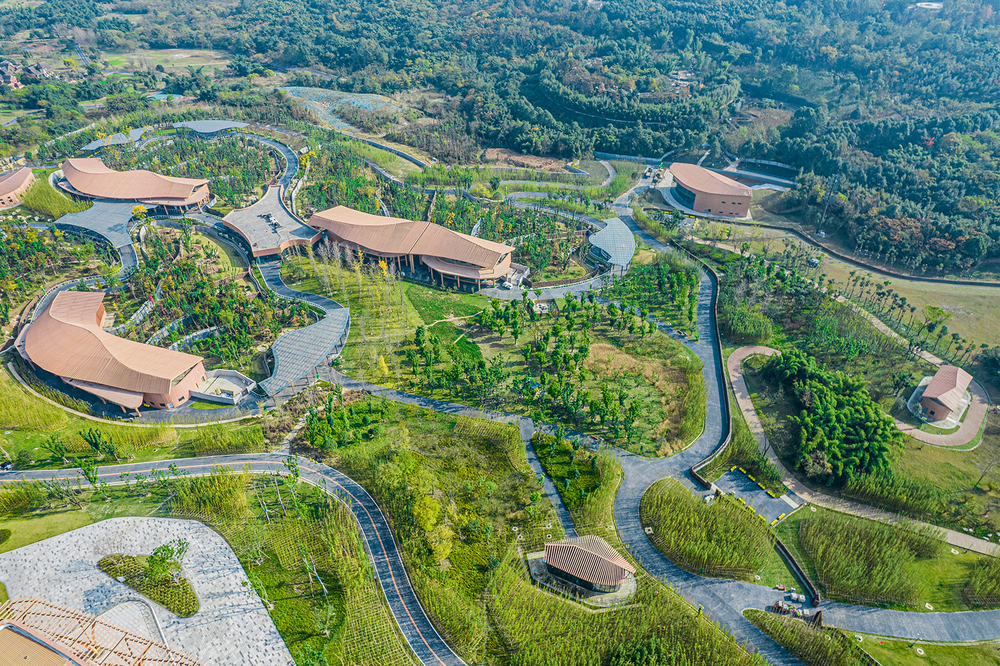
随着动物保护组织的宣传与教育,新一代的年轻游客不像过去那样热衷观看动物表演,他们更希望看到的,是动物们的自然状态和行为。项目通过场景营造、交通方式、游线设计以及景观策略打造沉浸式的游览体验。通过在各个片区符合主题的场馆场景与熊猫相关的故事进行串联,使游客在为动物打造的原生生境中模拟成为一个误入秘境的闯入者,对未知的自然进行探索,从中收获知识与感动,让他们在今后的人生中获得对保护动物与自然的重要性更深刻的认识。
▼多种观赏方式,Observing Method ©天华规划 Tianhua
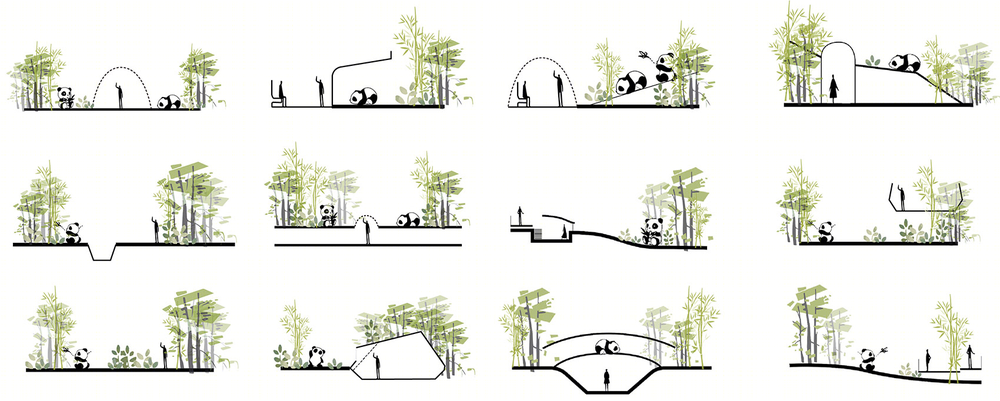
▼平日&高峰日观光车线路,Weekday&Peak Day Circulation ©天华规划 Tianhua
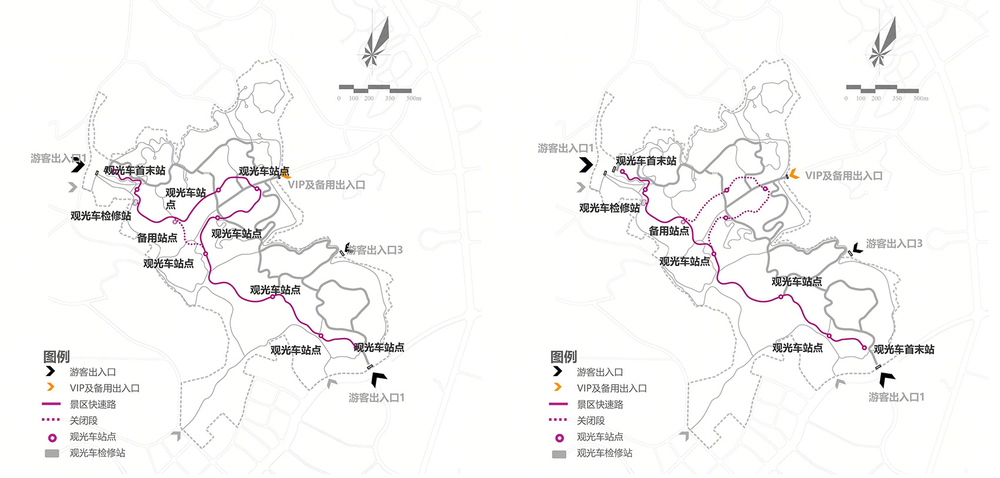
With the promotion and education of animal protection organizations, the new generation of young tourists are not as keen to watch animal performances as they used to be. What they want is the natural statue and behavior of animals. “Panda base” achieves immersive touring experience through theme building, transportation method, routing planning and landscape strategy. By connecting the theme of individual area with panda related stories, the tourists are pretended to be “strayers” in a hidden scenic spot inside the natural habitat built for animals. The experience of exploring in the nature would help them better understand the importance of protecting animals and nature.
▼熊猫塔,Panda Tower ©成都天府绿道建设投资集团有限公司
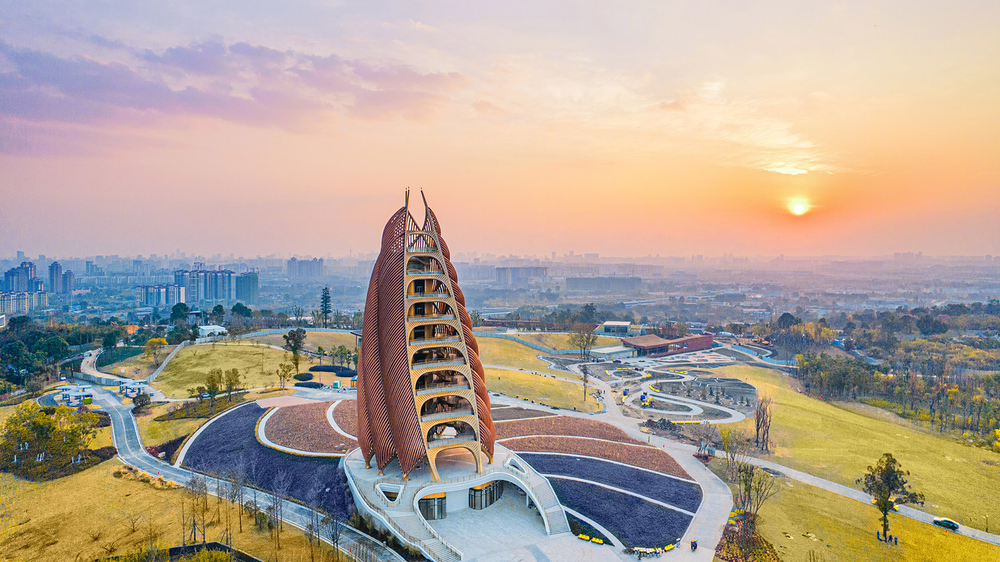
大熊猫繁育研究基地改扩建工程已于2020年开工建设, 预计2021年底竣工并于2022年一月正式对外开放。规划设计对于熊猫基地的变化将不仅体现在场地面积、场馆布局、熊猫数量、游客数量等数据上的增长上。同时也是规划理念的一场落地实践。“人类友好。动物友好”的理念是我们贯穿大熊猫繁育研究基地改扩建的精髓和根本所在:在城市中最大程度地还原大熊猫原生生境,也创造性地打造了沉浸式的科普教育场所。他将是成都公园城市中一个自然和谐的城市公园典范、城市中生命共同体的一场实践。人,熊猫,城市一起探索未来,与自然和谐相处的更多可能性。
Panda base expansion project started in 2020 and plans to complete by 2021. The strategy of the panda base expansion not only increases the facility size, building layout, panda quantity and tourist amount, but also is a practice of the essential vision “animal friendly, human friendly” through the entire project. The project restores the giant panda natural habitat and creates immersive scientific and popular knowledge education facility. It will serve as a model of natural harmony urban park and a transformation to a community of shared future. Human, panda and city explore the future together in harmony.
▼入口商业街与大门,Commercial Street ©成都天府绿道建设投资集团有限公司
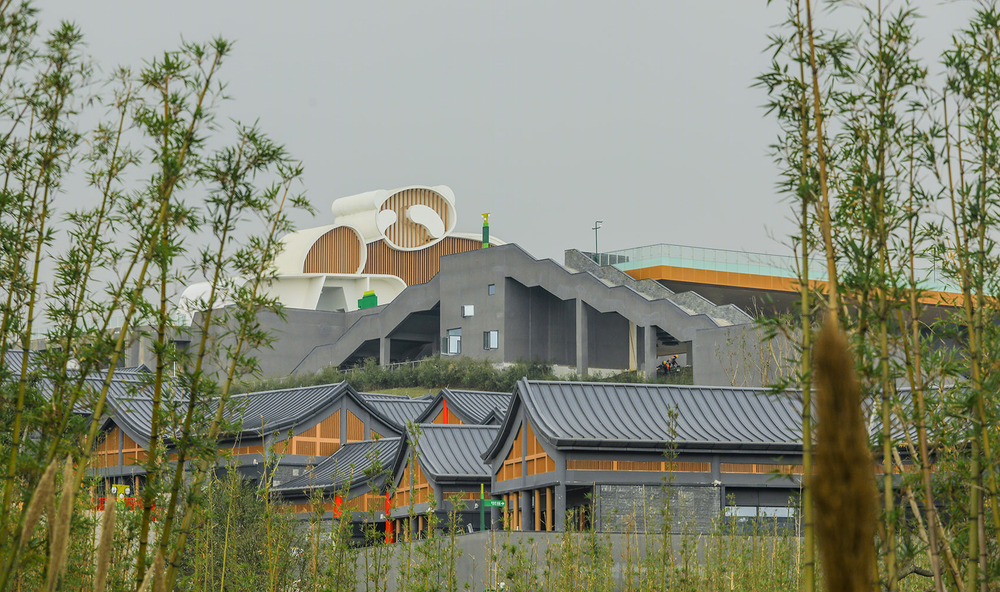
▼大熊猫繁育研究基地掩映于自然之中, Integrated with Nature © 天华规划 Tianhua
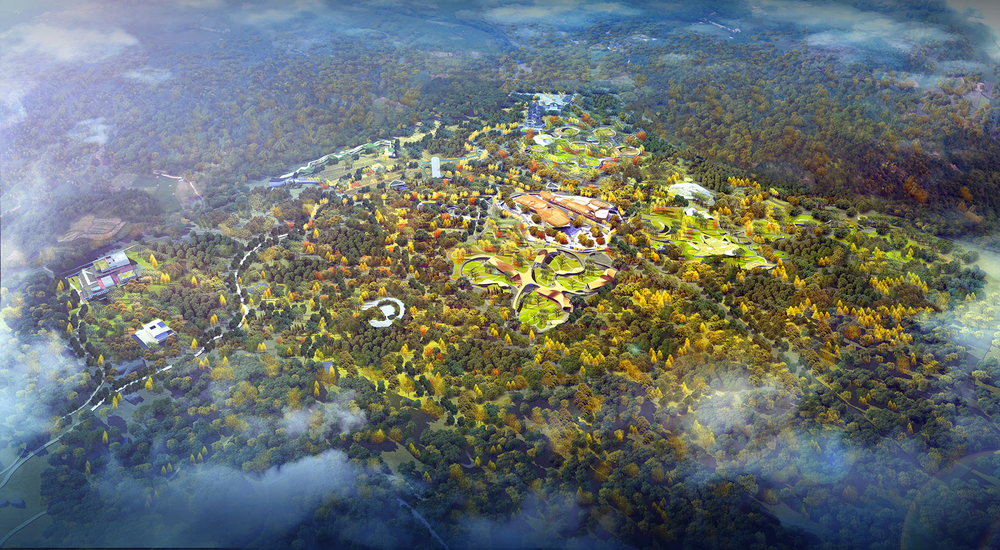
▼项目更多图片
